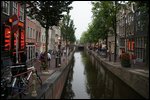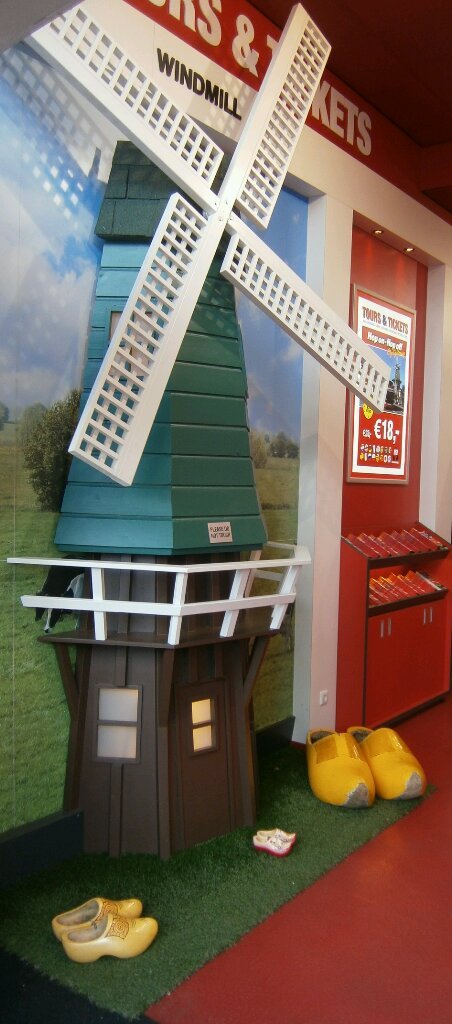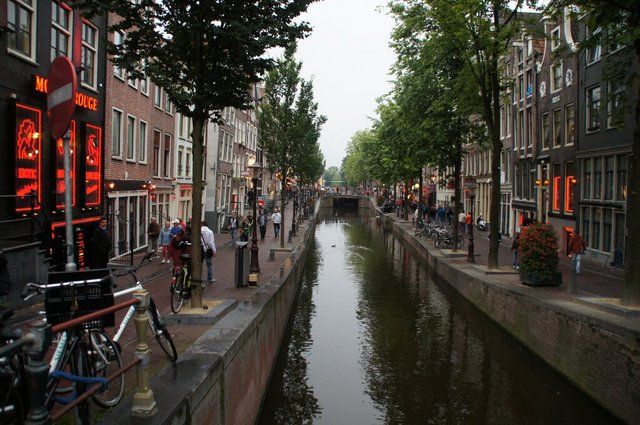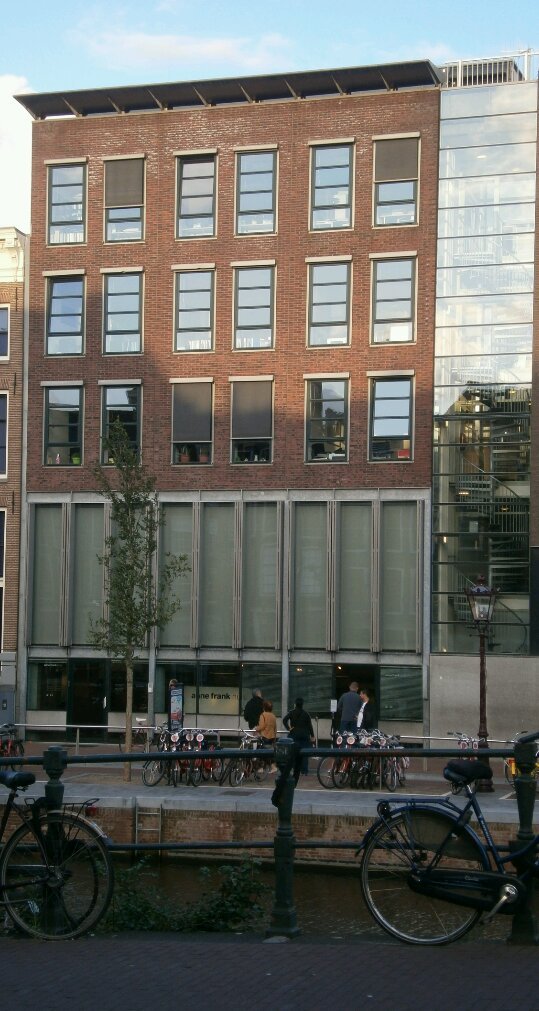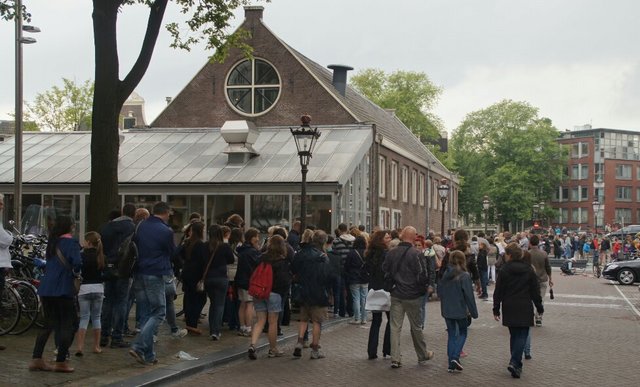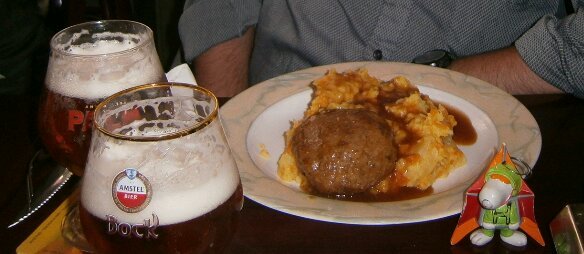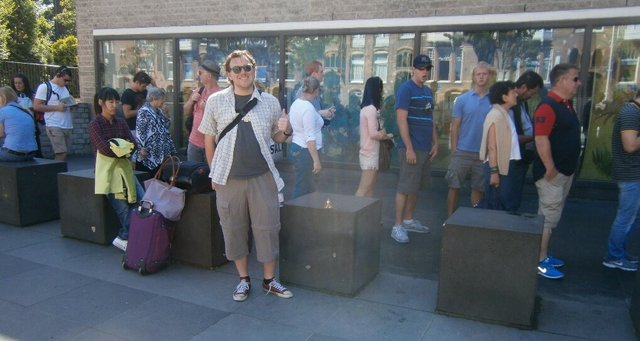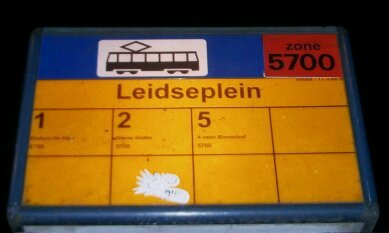On the Amstel there was built a dam, and thus Amsterdam came to be. We arrived early in the morning, and for the first time I remembered to put on my step counter. Over an English breakfast we discussed what to do in the Dutch capitol, and not surprisingly, the agreed upon itinarary focused on sex, drugs and museums. And, time permitting, sex museums and possibly drug museums.
But Amsterdam also has canals, and a boat cruise is more or less required, and so, we took one. From the canals one has an excellent view of the typical Amsterdonian architectural trick of gavels leaning out, thus creating a sort of overhang. And why, one wonders? Well, as the buildings were taxed based on width, most houses in old Amsterdam are extremely narrow, tall and deep. With narrow houses you can't waste valuable space on such nonsense as big stairs, and thus the puny excuses for stairs were useless for moving furniture. Lo and behold: A hook-equipped beam protrudes from the roof, making it easy enough to pull your heavy and big furniture and take them in through the windows, and the leaning walls hinders the slightly rocking goods to smash into the walls or windows.
Moving on to drugs, specifically the mood enhancing substance that the Netherlands is most famous for: different derivatives of cannabis.
Unlike what Travolta says in Pulp Fiction, it's actually illegal to own it, it's illegal to carry it, and if you're the proprietor of a hasch bar it's illegal to sell it. But but that doesn't matter though, 'cos get a load of this: Those are simply laws that the government just don't enforce. The main policy, not only in drug related issues, but in almost all cases of tolerance is: If it's adequately good business, if it's done out of sight, and if it doesn't hurt anybody, then it's accepted. And cannabis, as consumed in the many coffeeshops throughout the Netherlands certainly fit all those criteria neatly. Thus coffeeshops, and the accepted providing of spacecakes, joints, and sativa saturated bongs.
Of course the cannabis plant can be used for many other things, such as hemp for rope, sails and paper, and the active substances has a great many medicinal purposes, and that's what the Cannabis, marijuana and hemp museum is for.
Back in the days, when Amsterdam was a bustling harbour, and the sailors, having spent months out on the open sea with nothing but other men as company, what would be the first thing they would do when finally reaching port? That's right, unload all the goods and wares on board. But after that, off to the women of negotiable affection. Once the largest port in the world, Amsterdam has a history of needing to cater to the sailors. And the church wasn't late to partake in the monetary advantages of an industry that always has, and always will exist in one form or another: After the sailors and others, called by nature, had set off to sin, they had to set off to the confession booth. And the forgiving of sins comes with a price, and thus the church, even though officially strongly against the heinous sin that is sex between consenting adults, made a pretty penny from the sex industry.
And with the Dutch motto of 'If it's adequately good business, if it's done out of sight, and if it doesn't hurt anybody, then it's accepted', the ladies of the night continued to have a steady business in the Dutch capitol.
As of 2000, prostitution is perfectly legal in the Netherlands, as long as the workers are over 18, from the EU and are registered as such. And the Red light District is where many of them work, and that's where we took another guided tour.
Amsterdam is the city with the most museums per capita in the world. They have the above mentioned Cannabis, marijuana and hemp museum, a glasses museum, a bags and purses museum and a cat-boat museum, to name a few.
All the guidebooks say to get a ticket beforehand when vistiting Anne Frank's house. Agreed, if you plan to go there during the day; the queue is incredibly long. However, if you happen to be in the neighbourhood at nine-ish in the evening, you could easily get in without having to stand in line at all, and you have a good hour to see and reflect over the tragic but inspiring story of the hidden Jews in the attic, as told by the 15 year old Anne Frank. That's what we did. Another, equally crowded museum that is a must is the van Gogh one. Why all those people stand all that time in line is a mystery. Tickets are easily available in one of the dozens of tickets&tours shops spread throughout the city centre; just drop in, buy the ticket and glide past the waiting doofuses* while trying not to point and laugh, Nelson Muntz-style. That's what we did.
We also took one of those free walking tours, and as per usual you get a feel of the city, its history, its geography, its maths... Which is connected to what Amsterdam is all about: Money. As the trade with India and China took off, many merchants followed suit, and in order to spread the risks of losing their ships to the many tremors of the sea (pirates, storms, ninjas, other countrie's fleets, mutiny, mis-navigation etc), they got together, putting all their ships in, and spread the winnings equally among the participating merchants, thus making a good profit even if a few of the ships didn't made it back. Eventually regular people could join with money for parts of ships, taking a smaller piece of the cake, but a cake nonetheless. And so, the stock exchange was created. Blame, or praise, the Dutch for that.
Holland, like all northern/central European countries, has beer. And contrary to popular belief, it's not just Heineken. It's also Grolsch and Amstel, so there. So, besides windmills, clogs, tolerance, ice skaters, ladies-in-windows, liberalism, Heineken, cannabis, van Gogh, tulips and being the tallest people on earth, what is the Netherlands known for? Yep, their funny language. One of the funnier words would have to be the name of one of their favourite meals/snacks: Bitterballen. (Un)fortunately I didn't get chance to try that, but at least I sank my teeth into another traditional Dutch dish: Stamppot (basically a mix of mashed potatos, carrots and other roots and veggies, served with gravy and a giant meatball).
Oh, and cheese.
Step count Amsterdam: 45 516, which over 2,5 days gives an average of 18 206 steps per day.
*) Doofi, I know, I know...

